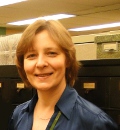Diatom Scientist Elected to Lead International Society
PHILADELPHIA,
October 23, 2012

Dr. Marina Potapova, new vice president of the International Society for Diatom Research
Download hi-res image.
Home of one of the world’s largest diatom collections, the Academy of Natural Sciences of Drexel University now has a major seat at the International Society for Diatom Research. The Academy’s Assistant Curator of Diatoms Dr. Marina Potapova, who manages the museum’s Diatom Herbarium, has been elected vice president of the society. The goal of the society is to educate the public about diatoms and promote the importance of diatom studies.
Diatoms are one-celled algae that are found in every water body on Earth. Though they can only be seen with a microscope, diatoms produce one-fifth of all the oxygen on the planet and are a common tool for monitoring environmental conditions, particularly water quality.
Potapova was elected at the recent International Diatom Symposium in Belgium. A diatom curator at the Academy since 2008, Potapova’s research focuses on the taxonomy, ecology and biogeography of freshwater diatoms of Europe, Asia and North America. She and her team are working to digitize the Academy’s Diatom Herbarium of about 200,000 slides, many dating to the 19th century, so that they can be more accessible to researchers around the world through a computer.
“It is a great honor to serve the International Society for Diatom Research,” said Potapova, an assistant professor in the Drexel University Department of Biodiversity, Earth and Environmental Science. “I look forward to working with members of our society on advancing diatom studies by facilitating access to scientific resources, engaging the next generation of diatom researchers, and promoting international collaborations.”
Diatoms lie at the base of the food chain, and fossil and molecular evidence shows they originated around the Jurassic Period, 200–145 million years ago, when large reptiles dominated the land and before giant plant-eating dinosaurs began to proliferate. In the 1940s, the Academy’s Dr. Ruth Patrick pioneered the study of diatoms for determining whether a body of water was polluted.
Media Contact